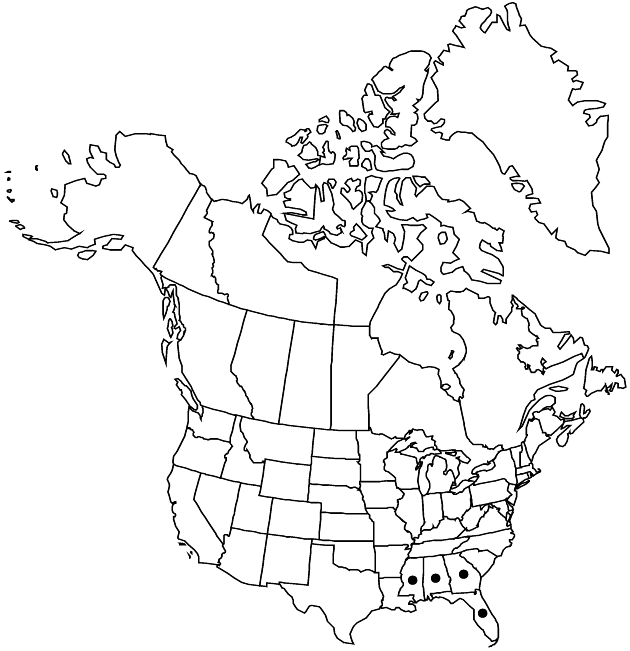Liatris elegans var. kralii
Sida 20: 601, fig. 4. 2001.
Corms depressed-globose. Heads well-spaced. Phyllaries: apices petaloid, initially light yellow or cream, fading to cream, sometimes pale lavender to rose, slightly flaring-divergent or nearly straight, petaloid portions long relative to herbaceous bases. Corollas pure white.
Phenology: Flowering Aug–Oct(–Nov).
Habitat: Sandhills, edges of wet savannas, dunes, stream banks, sandy-clay ridgetops, turkey oak, bluejack oak, longleaf pine-oak
Elevation: 50–200 m
Distribution

Ala., Fla., Ga., Miss.
Discussion
Variety kralii has been collected from South Carolina (Allendale Co., Ahles 20905, NCU), where it appears to be disjunct from closest populations in southern Georgia. Intergrades between var. kralii and var. elegans are encountered in Alabama and Mississippi and vars. kralii and elegans appear to be sympatric in Alabama and Georgia.
Selected References
None.
Lower Taxa
None.
"plumose" is not a number."fine" is not a number.
... more about "Liatris elegans var. kralii"
introrse +
connate +
petaloid +
flaring-divergent +
pale lavender;rose +
straight +
prolonged +
spreading +
dilated +
scarious +
absent +
hirsute +
papillate +
spiciform +
dense +
continuous +
herbaceous +
glabrous +
decurrent +
mostly linear;ovatelanceolate +
(4-)5-angled;10-ribbed +
hyaline +
linear-clavate +
stigmatic +
barbellate +
12;40 +
coarse +
absent +
glabrous +
not 2-lipped +
white +
equaling +
monomorphic +
8-11-ribbed +
prismatic +
3.5mm;5mm +
straight +
distinct +
proximal +
4;5 +
bisexual +
dispersed +
singly +
Sandhills, edges of wet savannas, dunes, stream banks, sandy-clay ridgetops, turkey oak, bluejack oak, longleaf pine-oak +
discoid +
well-spaced +
indeterminate +
homogamous +
surrounding +
turbinate-cylindric +
1-nerved +
alternate +
oblanceolate +
2-carpellate +
inferior +
attached +
anatropous +
persistent +
absent +
tough +
thick +
connate +
nerved +
persistent +
distinct +
falling +
unequal +
equal +
petaloid +
Sida +
2001 +
absent +
epaleate +
conic;spheric;usually flat;convex +
fibrous +
exalbuminous +
modifed +
3;4 +
alternate +
erect +
2-branched +
hirsutulous +
papillate +
Liatris elegans var. kralii +
Liatris elegans +
variety +
perennial +